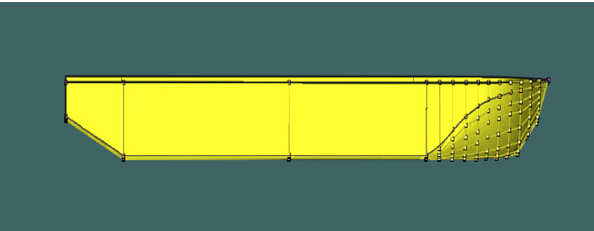Analysis Of Motion Trajectory And Fatigue Damage Ratio Fpso To Catenary Mooring Line Failure
Main Article Content
Abstract
Floating Production Storage and Offloading (FPSO) is a ship that produces floating oil and gas by having a catenary mooring type mooring system. The FPSO will produce oil and gas in the Abadi Field in the Masela Block of the Arafuru Sea (09˚ 07' 51'' S / 130˚ 28' 00'' E) where the area has sea waves, wind and currents which will affect performance FPSO ship. In this research, Response Amplitude Operator (RAO), motion trajectory and fatigue damage ratio will be tested with a ship mooring system of 12 ropes, 3 of which experienced failure. The conclusion of this research is that the more mooring ropes break, the farther the FPSO ship will move from its initial condition and the higher the maximum rope tension value, it will be directly proportional to the stress range on each mooring rope, while for the fatigue damage ratio, the higher the failure cycle value. then it will be inversely proportional to the fatigue damage ratio value for each mooring rope.
Downloads
Article Details

This work is licensed under a Creative Commons Attribution 4.0 International License.
Allow anyone to modify, improve, and make derivative works, even for commercial purposes, as long as they credit to you for the original work.
Deprecated: json_decode(): Passing null to parameter #1 ($json) of type string is deprecated in /home/journal33/public_html/plugins/generic/citations/CitationsPlugin.inc.php on line 49
References
Djatmiko. E.B. Perilaku dan Operabilitas Bangunan Laut di Atas Gelombang Acak, Jurusan Teknik Kelautan. ITS Surabaya. 2012.
Nugteren F. Flexible Riser Fatigue Analysis: Studying Conservatism in Flexible Riser Fatigue Analysis and Development of an Engineering Model to Study Influencing Parameters of Local Wire Stress. Master of Science Thesis. Netherlands: TU Delft; 2015. h. 10-12.
Bannantine AJ, Comer JJ, Handrock LJ. Fundamental of Metal Fatigue Analysis. USA: Prentice Hall; 1990. h. 1-10.
DNV OS E301. Position Mooring. Norway: Det Norske Veritas; 2004. h. 35-37.
Nallayarasu. Offshore Structures Analysis and Design. India: Indian Institute of Technology; 2015. h. 99-100.
Saidee MH. Fatigue Analysis and Design of Mooring Systems: Assessment and Comparison of Different Methods. Master of Science Thesis. Norway: NTNU; 2015. h. 3-4.
Vryh of Anchors BV. Anchor Manual: The Guide Anchoring. Netherlands: Capelle a/d Yssel; 2010. h. 7-8.
Larsen K. Lecture Note: Mooring and Station Keeping of Floating Structures. Norway: NTNU; 2014. h. 10-13.
Chrolenko MO. Dynamic Analysis and Design of Mooring Lines. Norway: NTNU; 2013. h. 3-4.
B. Purnama and F. M. Assidiq, “Numerical Studies Fatigue Damage From Material Variations Catenary Mooring System FPSO Al Zaafarana”, Journal of Maritime Technology and Society, vol. 3, no. 1, pp. 52-62, Feb. 2024.
N. S. Aulia and F. M. Assidiq, “Comparative Numerical Analysis Fatigue Damage Based On Variation In Quantities Mooring Line On Aker Smart 2 FPSO”, Journal of Maritime Technology and Society, vol. 3, no. 1, pp. 21-32, Feb. 2024.
A. E. Ramadani and F. M. Assidiq, “Analysis of The Effect of mooring Depth & Fatigue Damage on Mooring Line FPSO Ship Azurite In The Masela Block”, Journal of Maritime Technology and Society, vol. 3, no. 1, pp. 33-42, Feb. 2024.
M. H. Ba Naga and F. M. Assidiq, “Mooring Design and Fatigue Damage on Variant Fairlead Positions During FPSO Operation – Case Study”, Journal of Maritime Technology and Society, vol. 3, no. 1, pp. 43-51, Feb. 2024.

